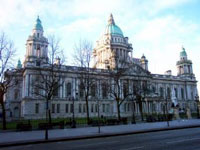 Belfast OverviewThe fortunes of Belfast have risen and fallen over time, from
its beginnings as a Bronze Age settlement to extensive World War II
bombings and civil conflict. Today, the capital of Northern Ireland
is a thriving city that has regained some of its old charm and
industry, and has begun to lure the odd curious traveller or two.
City breaks in Belfast are becoming increasingly popular, with a
variety of low-cost European carriers offering cheap flights to
Northern Ireland's capital. Belfast is situated near the mouth of the River Lagan, and
blossomed in the 17th century with an influx of English and
Scottish settlers. The port city grew in prominence during the
Industrial Revolution, with booming linen, rope-making and
shipbuilding industries. The ill-fated Titanic was built here in
the Harland and Wolff shipyards, and today Belfast still boasts the
world's biggest dry dock, as well as a restored Waterfront Complex
that houses chic restaurants, shops and ubiquitous Irish pubs. Much of the city's architectural heritage was destroyed during
repeated bombings in World War II, as well as during the Troubles -
a period of civil conflict between Roman Catholic nationalists and
Protestant unionists that raged from 1969 until the late 1990s.
Several exquisite Victorian and Edwardian buildings remain,
however, and have been filled with trendy bars, boutiques,
galleries, museums and restaurants in an attempt to regenerate the
city's image. Evidence of the Troubles can still be seen in the
many murals that line Falls Road and Shankill Road, and the Europa
Hotel has become famous as one of the most-bombed buildings in
Europe, having being targeted no less than 27 times. Belfast is often overlooked as a tourist destination, but its
fascinating history, ongoing struggles, many attractions and above
all, the warmth and acerbic wit of its inhabitants, make it an
interesting stop on any tour of the United Kingdom. It also serves
as an excellent base from which to explore the many natural wonders
of Northern Ireland. |